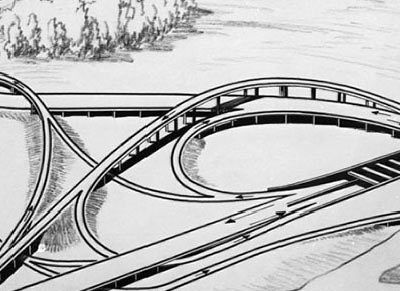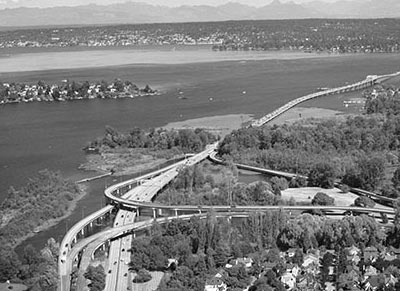AUDIO
MP3 Download: Listen to Dr. Lorraine McConaghy, the Public Historian at the Museum of History and Industry (MOHAI) , talk about engineering visions and the different attitudes between the old Thomson-type engineering and the emerging attitudes that are embodied in the 520 bridge.
RESOURCES
Links to external websites do not constitute endorsement by WSDOT of the linked websites or the opinions, information, products or services contained therein.
The Ramps to Nowhere on the Montlake-area WSDOT peninsula are remnants of the never-completed, long-defunct R.H. Thomson Expressway. Plans for the "Empire Expressway" (as it was also known) along the eastern border of the Washington Park Arboretum were underway as early as 1930, but did not progress very far until the 1950s. It was then that city engineers began developing plans for a route between the end of Empire Way in south Seattle (today's Martin Luther King Jr. Way South) at Rainier Avenue South and the Meadowbrook neighborhood in northeast Seattle.
A 1958 map in the city archives shows the proposed route of the four-lane expressway along the east side of Capitol Hill, roughly following a route between 28th Avenue East (Martin Luther King Jr. Way) and 29th Avenue East south of the ship canal and 24th and 25th avenues north of the canal. A tunnel would have carried traffic under the ship canal. The state envisioned a connection between this planned expressway and the Seattle Freeway, as Interstate 5 was then known. To that end, the highway department planned an interchange in the Roanoke neighborhood, which would connect with a roadway across the shoulder of Capitol Hill. It would also connect across a bridge over Portage Bay to the Montlake neighborhood. An interchange on the Arboretum land would carry traffic between this new road and the planned expressway and, potentially, a new bridge across Lake Washington.
On March 8, 1959, the state Legislature passed legislation removing the two blocks from the Washington Park Arboretum it had given to the University of Washington in 1939. The land included the marshy area that contained the Miller Street Landfill site. Dredging for the project isolated a finger of land around the landfill, extending out into the lake, which became known as the WSDOT Peninsula.
In response to these actions and their inevitable community impact, the Citizens Against the R. H. Thomson (CARHT) was formed by neighborhood and environmental advocates. Their dedication was instrumental in stopping the highway project. On June 1, 1970, the Seattle City Council voted to remove the proposed highway from the city's Comprehensive Plan. That vote essentially killed the project, although the bonds approved in 1960 remained on the books. The City Council cancelled the contract with the state for the R. H. Thomson Expressway project in 1971, and ramp construction was stopped in various stages of development. The City Council set a final referendum on the R. H. Thomson Expressway during the Feb. 8, 1972, election, asking voters to formally terminate the approval the City had granted in 1960 for that highway and its bonds (which had never been issued). Nearly 71 percent of those voting approved Referendum 2, which terminated that project.
The federal government, which was funding a significant portion of the construction costs for the proposed Seattle Freeway, had required that the city build a second Lake Washington bridge. The Evergreen Point to Montlake alignment was selected, to the chagrin of local residents and Arboretum advocates. The new Evergreen Point Floating Bridge, which had been completed in 1963, included two ramps in the Arboretum area. These opened along with the bridge in 1963, but the ramps intended for the R.H. Thomson Expressway remained in place, incomplete and unused for 50-plus years. As part of construction of the new Governor Albert D. Rosellini Bridge (also known as the Evergreen Point Floating Bridge and the SR 520 bridge), the ramps across the WSDOT peninsula are being removed.
Visit HistoryLink.org to read more about the R.H. Thomson Expressway and the Ramps to Nowhere.

